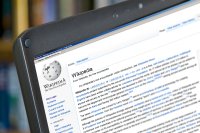Teaching Students How to Use Wikipedia Wisely
Understanding how the online encyclopedia functions helps students learn how to conduct research and distinguish fact from fiction.
When my high school students begin a new assignment that calls for online research, I often ask what websites they shouldn’t use. Almost every student exclaims, “Wikipedia!”
“Why?” I ask, even though I already know their response. “Because anyone can write anything,” someone typically replies. When I tell them that they can use Wikipedia, the students often look at me in confusion. Then I add that they have to use the website correctly.
Wikipedia is the fifth most visited website in the world, with more than 40 million articles accessed every month. College and university professors are increasingly turning to the online encyclopedia. Even doctors may find information on Wikipedia.
Effectively navigating a Wikipedia article can provide students with an opportunity to learn about peer review, sourcing, footnotes, and internet research. It also teaches critical-thinking skills.
A Starting Point
Did you know that the South American coati, a small mammal in the raccoon family, is also known as the Brazilian aardvark? Of course not. While coatis do exist, they were never called Brazilian aardvarks until a 17-year-old added that invented fact to the animal’s Wikipedia page in 2008.
Wikipedia, like much of the internet, is the Wild West of information. Wikipedia’s writers and editors need not be experts, nor has the information necessarily undergone any type of peer or editorial review. Before using Wikipedia, students must understand the peer review process and the way scholars publish information in books and academic journals.
After a professional completes his or her manuscript or research, experts in the field evaluate and critique the work before sending it back to the author for continued revision. The peer review process aims to guarantee that the finished product exhibits a high degree of authority on its topic. Wikipedia excludes this critical step.
Students should understand that Wikipedia is a starting point. While they should never cite or rely on the website, the information found there can direct them to more reliable sources. Teachers might present Wikipedia as an enormous digital card catalog pointing users in a multitude of directions. The online encyclopedia gives helpful advice on how to use the site.
Work Smarter, Not Harder
Anyone can sign up and create a Wikipedia page or edit an existing one. Thankfully, these contributors typically indicate the sources they used to write or add to an article.
In the beginning stages of research, students should develop a big-picture perspective on a topic. Many Wikipedia pages include “Other Sources” sections, “Bibliography” sections, and a host of “External Links.” These citations can be more important than the actual article, but most students may not appreciate their importance.
For example, the Wikipedia page on Theodore Roosevelt has citations for 15 full-length biographies of the former president as well as bibliographic information for materials concerning his personal life, domestic policies, foreign policies, and politics. The article features links to nearly 20 primary-source documents related to Roosevelt’s life that can serve as a starting point or road map.
Once students have a list of seemingly adequate research, they need to locate the materials through the library or academic databases. Then they need to learn how to evaluate them for validity.
Follow the Footnotes
Wikipedia footnotes can offer more specific information for students conducting research. Recommend to students that they read through their chosen article carefully and take notes. Direct the students to the hyperlinked footnotes at the end of each sentence or paragraph. This might be an opportune time to review how to use footnotes, a method of citation directing readers to the provenance of a claim or fact.
Explain to students that their job is to essentially reverse-engineer the Wikipedia page, determining where the information originated by reading the footnotes, hunting down the references, and then investigating the source material.
While reading the article, tell students to click on the footnote of any interesting or useful facts to check the source of information for the article. In some cases, the citation will include a link to a website or online book that they can follow. In other cases, the citation might provide a hard-copy book or article that the student must acquire. Prompt students to record the citations associated with facts they would like to explore.
The footnotes they collect may offer a bibliography of both primary and secondary sources. Next, students must determine whether the source material is credible before they dig deeper and locate the particular information they first found relevant or compelling. Encourage students to research the author of the piece and ask questions such as the following:
- Is he or she an expert or someone others might consider an authority in the field?
- Does the author work at a university or prominent research facility?
- What are his or her credentials and other publications?
Then, investigate the reputability of the publisher and whether it’s likely that those in charge incorporated some form of editorial, journalistic, or peer review. Introduce the CRAP test, which stands for Currency, Reliability, Authority, and Purpose/Point of View.
Educators can use Wikipedia to help students, especially those less experienced in conducting research, become more critical consumers of information. The skills needed to discern fact from fiction on a Wikipedia page are the same skills needed for students to approach all media: patience, objectivity, critical analysis, and a willingness to use a variety of resources to check and double-check claims.
